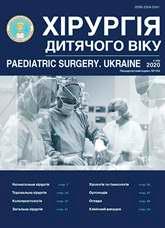Optimization of surgical treatment of rigid flat feet in children with posterior tibialis tendon dysfunction
DOI:
https://doi.org/10.15574/PS.2020.69.72Keywords:
flatfeet, children, surgical treatmentAbstract
The rigid form of static flatfeet occurs in 18 to 20% of cases of the musculoskeletal system pathology. To date, no objective diagnostic methods have been developed, no algorithms for treating the rigid form of flatfeet depending on the severity, deformity of the tarsal bones, foot mobility and dysfunction of the posterior tibialis tendon (hereinafter PTT).
Objective. To develop objective evaluation methods for mobility in the joints and changes in the tarsal bones. Create algorithms for surgical treatment of rigid foot.
Materials and methods. The effectiveness of the rigid form of static flatfeet treatment in 32 children (64 feet) aged 14 to 18 years, which were divided into main and control groups, was analyzed. Clinical and radiological diagnostic methods were used. Patients in the main group (15 patients) underwent surgery on bones and soft tissues.Patients in the control group (17 patients) were operated using subtalar arthroereisis method.
Results. Surgical treatment was ineffective in the use of subtalar arthroereisis in cases of the tarsal bone deformity and significant impairment of foot mobility. Positive results were also achieved using two-joint arthrodesis with the formation of naviculo-tibial ligament with severe foot rigidity, stage III–IV of PTT dysfunction and navicular bone deformity.
Conclusions. Treatment of rigid foot should take into account the severity, the compression ratio of the navicular bone, the mobility index, the stage of the posterior tibialis tendon dysfunction and the angle of its tension. Long-term results indicate the effectiveness of surgery on bones and soft tissues in the treatment of severe rigid flat feet.
The research was carried out in accordance with the principles of the Helsinki Declaration. The study protocol was approved by the Local Ethics Committee of participating institution.
References
Babu M, Anand V, Thanigai S. (2017). Results of modified Carroll technique in severe, resistant clubfeet. International Journal of Orthopaedics. 3(2): 801-805. https://doi.org/10.22271/ortho.2017.v3.i2i.86
Carroll NC. (2012). Clubfoot in the twentieth century: where we were and where we may be going in the twenty-first century. Journal of Pediatric Orthopaedics B. 21(1): 1-6. https://doi.org/10.1097/BPB.0b013e32834a99f2; PMid:21946867
Chatupon Chotigavanichaya, Jidapa Wongchareonwatana, Charikdhamma Saelim, Thanase Ariyawatkul, Kamolporn Kaewpornsawan, Perajit Eamsobhana. (2019). Comparison of ponseti method versus surgical treatment in congenital idiopathic clubfoot: A 5-year follow up study. International Journal of Orthopaedics Sciences. 5(3): 666-669. https://doi.org/10.22271/ortho.2019.v5.i3l.1610
Levitsky AF, Karabenyuk AV, Golubenko AA. (2019). Approaches to the surgical treatment of congenital clubfoot in children. Childs health. 14(1): 50-53. https://doi.org/10.22141/2224-0551.14.1.2019.157880
Mahesh Babu B. (2006). Surgical Management of Clubfoot by Modified Carroll's Technique. Doctoral dissertation. Madurai Medical College, Madurai.
McKinney J, Rac MW, Gandhi M. (2019). Congenital talipes equinovarus (clubfoot). American Journal of Obstetrics & Gynecology. 221(6): B10-B12. https://doi.org/10.1016/j.ajog.2019.09.022; PMid:31787157
Pirani S. (2004). A reliable and valid method of assessing the amount of deformity in the congenital clubfoot. St Louis, MO. Pediatric Orthopaedic Society of North America. 115-116.
Sodre H, Bruschini S, Nery C, Mizusaki J. (1994). The Cincinnati Approach in Clubfeet. In: Simons G.W. (eds). The Clubfoot. Springer. New York. 201-202. https://doi.org/10.1007/978-1-4613-9269-9_40
Turco VJ. (1979). Resistant congenital club foot-one-stage posteromedial release with internal fixation. A follow-up report of a fifteen-year experience. The Journal of bone and joint surgery. American volume. 61(6A): 805-814. https://doi.org/10.2106/00004623-197961060-00002
Varma HS, Alok C. Agrawal, Pradeep K Singh. (2013, Jan-Jun). Surgical management of congenital idiopathic clubfoot by twin incisions. Journal of Orthopedics and Allied Sciences. 1(1): 18-21. https://doi.org/10.4103/2319-2585.117383
Wilkinson BG, Glass NA, Cook TM, Morcuende JA. (2018). Surgical Management of Idiopathic Clubfoot in the United States from 1997-2012: An analysis of 11,940 discharges. doi: https://doi.org/10.1542/peds.142.1_MeetingAbstract.297.
Zatsepyn TS. (1947). Vrozhdennaia kosolapost y ee lechenye v detskom vozraste. M.: Medhyz. 37.
Feng Lin. (2016, Aug). Observation of curative effect by Carroll operation approach in the treatment of congenital talipes equinovarus. Chinese Practical Medicine. 8–9.
Downloads
Published
Issue
Section
License
The policy of the Journal “PAEDIATRIC SURGERY. UKRAINE” is compatible with the vast majority of funders' of open access and self-archiving policies. The journal provides immediate open access route being convinced that everyone – not only scientists - can benefit from research results, and publishes articles exclusively under open access distribution, with a Creative Commons Attribution-Noncommercial 4.0 international license(СС BY-NC).
Authors transfer the copyright to the Journal “PAEDIATRIC SURGERY.UKRAINE” when the manuscript is accepted for publication. Authors declare that this manuscript has not been published nor is under simultaneous consideration for publication elsewhere. After publication, the articles become freely available on-line to the public.
Readers have the right to use, distribute, and reproduce articles in any medium, provided the articles and the journal are properly cited.
The use of published materials for commercial purposes is strongly prohibited.

